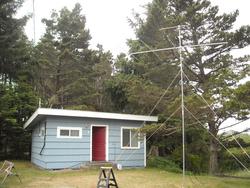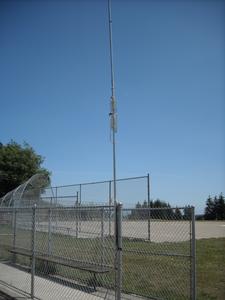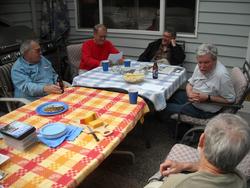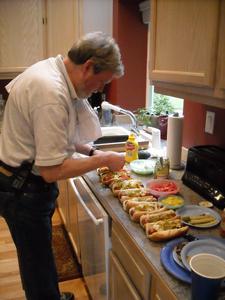 July 8, 2009 Editor: Ward Silver, NØAX | ||||||
IN THIS ISSUE
NEW HF OPERATORS - THINGS TO DO The regular North American Sprints are coming up in September, but their fast pace is somewhat intimidating. The Northern California Contest Club's Slow Speed NS practice sprint runs from 0200Z to 0215Z (Friday UTC, Thursday local time) with a 100-watt limit. Look for stations around 14037-14043, 7037-7043, and 3537-3543 kHz for about 5 minutes of practice on each band, beginning with 20 meters. Duplicate contacts are allowed with at least one intervening QSO on the same band. The recommended maximum speed is 23 WPM, so don't be afraid to jump in and call CQ! (Thanks, Mike W9RE) BULLETINS It was just such welcome news that it seemed appropriate to run this item from SpaceWeather.com as a bulletin: "Solar observers haven't seen an active region like [#1024] in more than two years. It is big, complex, and rapidly growing. The magnetic polarity of the sunspot, revealed by SOHO magnetograms, show that it is a member of new Solar Cycle 24. This makes sense: New research shows that solar jet streams are beginning to stimulate new-cycle sunspot production. Sunspot 1024 appears to be a sign of the process at work, heralding more to come." BUSTED QSOS A Golden Issue last time! CONTEST SUMMARY Complete information for all contests follows the Conversation section July 11-12
July 18-19
NEWS, PRESS RELEASES, AND GENERAL INTEREST
During IARU contest there will be four teams operating from the WRTC-2010 field locations with WRTC-2010 set ups using WRTC-2010 rules and the special calls R31WRTC, R32WRTC, R38WRTC, R39WRTC. The only difference between now and WRTC in 2010 is that they will be using towers 10 meters tall instead of 12 meters during WRTC-2010. Potential WRTC competitors may find this a very useful opportunity for evaluation. (Thanks, Harry RA3AUU)
Join the first ever IEEE Antenna Design Challenge sponsored by IEEE Antennas and Propagation Society by building an Antenna Demonstration System that can be used to teach the magic of antennas. The top three teams (or individuals) will receive up to $2,500 in travel funds to attend the IEEE Antennas and Propagation Symposium in Toronto, Ontario, July 10-17, 2010 to demonstrate their working systems. From these top teams, First ($1,500), Second ($750), and Third ($250) Place will be announced at the 2010 IEEE AP Awards Banquet. CQ WPX Director, Randy K5ZD is experimenting with Twitter as a way to help people gain an understanding about what goes on inside the job of managing a large contest like CQ WPX. Follow the full year journey through processing 7000+ logs, generating the results, managing the web site, and answering questions about the rules. Official announcements will continue to be made on the CQ WPX Web site and blog. The Twitter feed is just for fun. The folks at DX Summit have announced some new upgrades to the system. For example, each spotting and spotted call sign is automatically linked to QRZ.COM, providing a more human link to the personal profiles of people and to their pictures. Clicking on the call signs will automatically take the clicker to the relevant QRZ.com page. Additionally, each line carries the name of the DXCC country spotted. The next step is to provide custom selected filters that will allow users to receive personalized spots that they would like to receive. While initially the selected spots will be sent to your personal email address, the ultimate aim is to offer an SMS (short message service) option to DX Summit users. Also, a Help Desk for regular users and for S/W developers is being set up. (Thanks, Jarmo OH2BN)
The 2009 Mid-Atlantic VHF Conference, Sep 26 in Plymouth Meeting, PA, is now accepting registration, papers, abstracts, and speakers. Please submit your paper on amateur VHF, UJF and microwave communications including theory, construction, operation, antennas, roving, VHF-related software and hardware to Paul Drexler, W2PED. The 2009 ARRL/TAPR Digital Communications Conference has also issued a call for papers. This conference is also on the September 25-27 weekend, in Chicago, IL. Papers will be published in the Conference Proceedings (you do NOT need to attend the conference to have your paper included in the Proceedings). The submission deadline is July 31, 2009. Please send your papers or questions to Maty Weinberg at the ARRL. Interoperability takes on many forms and here's a new radio that is promoted just for that purpose in the public safety realm. (Thanks, Lowell KD7DQO) It's thunderboomer season across North America and NOAA has published a lightning-safety page that might be worth forwarding to family and friends. (Thanks, Julius N2WN) As the new solar cycle, wobbly as a new foal, gets its spots going, news arrives of the passing of Jack Eddy, the scientist that discovered the Maunder Minimum. (Thanks, Diane NH6HE) Web Site of the Week - Aficionados of a good spoof will enjoy digging in the on-line QST Archives for K9ODE's (now W5FG) - "The Templeton Case" - in January 1963 QST. (Log on to the ARRL Members Only Web page and click "QST Archive Search".) While you're reading, take a look at the ads to learn how you can "Stop that Highway Waggle" with a WONDEROD antenna! (Thanks, Jim K1TN) WORD TO THE WISE The ARRL Searchable Contest Database is a rich source of data for studying the results of other contesters. Click "Searchable Database" from any contest on the Contest Branch Results page, then select the contest you're interested in. Use the "Select Entries to List" and/or "Sort Order" windows to display the data you want. To get the whole file, click on Comma-delimited (CSV) or Tab-delimited using your right mouse button and select Save Link As... or Save Target As...to grab the data. If you're trying to save just one column or a block of data, press the Control key while holding down the left button of your mouse to select just the data you want. Then copy-and-paste into a text file, word processor, or spreadsheet. SIGHTS AND SOUNDS The archive of PVRC's first Webinar, "Lowband Contesting and DXing - A Look at the Tajikistan Observatory Station," by EY8MM, can be viewed on the Potomac Valley Radio Club's Web site by clicking on the "Webinar " link. That will launch the Windows Media Player. The link also takes you to the schedule for upcoming events. The Webinars are hosted on Neal K3NC's server. The next Webinar is "Design, Construction, and Maintenance of Antennas and Towers for Long Term Reliability" by Frank W3LPL. To register, just click on the title. (Thanks, Ken K4ZW)
Field Day videos abound including this great story and Soapbox entry about a budding CW operator. This is a great use for the GOTA station! Great live coverage from Kansas City's channel 4 station makes good viewing, too. Our group also worked W3AO a couple of times - their class was 20A, meaning that they had 20 transmitters on the air simultaneously - here are some photos of what a 20A operation looks like. And here's a presentation on "how they do it.". Videos of the six presentations at the AMSAT Forum at the 2009 Dayton Hamvention are now available online. They include, Richard Garriott's banquet talk on the ISS, an AMSAT and satellite operations status report along with updates on SuitSat-2, and a presentation on the Columbus Module Antennas by W5DID. (From AMSAT News Service Weekly Bulletin ANS-186) RESULTS AND RECORDS Certificates for the 2008 ARRL August UHF Contest and the 10 GHz and Up Cumulative Contest have been processed and shipped late last week. Winners should start to see them arrive any day. (Thanks, ARRL Contest Branch Manager, Sean Kutzko, KX9X) The official results of the 2009 Wisconsin QSO Party are now available online. (Thanks, Lynn K9KR) Tibor HA1AH writes to inform the contesting community that the final results of the 2009 HA DX Contest and downloadable certificate are now available on the contest's home page. Certificates can be downloaded until end of this year.
The 28 MHz SWL Contest runs along with the ARRL 10 Meter Contest in December. Those results are also available on the VERON Web site. Bill, W1-7897 turned in a pretty good performance, logging 13 states or provinces and 30 DXCC countries. This type of contest is good for non-hams thinking about getting a license. (Thanks, Ruud, NL290 / PG1R) Congrats to the CQ WW crew for finishing the log processing for last November's WW CW so quickly. Both logs and UBN reports are available. Excellent! (Thanks, Jim K1TN) OPERATING TIP Al AE2T contributed some words of wisdom to a beginner about getting a modest antenna system started. "Don't over-think it. Don't worry about patterns. Don't try to (over-) engineer it with modeling software. You aren't high enough to worry about a pattern and there are too many unknown variables to model it. Your engineering has been dictated by your circumstances, otherwise it would be 150 feet in the air and 150 feet long. Just get on the air with it. Every minute you waste thinking on it, reading (email reflectors), wondering "what-if" is a minute you aren't operating." There will be time for refinements and enhancements as you accumulate experience - don't let perfect be the enemy of good enough. TECHNICAL TOPICS AND INFORMATION The project of building the 8-Circle Vertical Array described in Chapter 7 of the 4th Edition of ON4UN's Low-Band DXing was tackled by ARRL President, Joel Harrison W5ZN and Bob N4HY. With the project completed, they wrote a "how-to" so that you can build your own. The writeup is quite detailed and includes many helpful figures and photos along with a theoretical description of how it all works. Pete N4ZR has been experimenting with Clifton Labs active antenna and various common-mode choking schemes. "It's conventional wisdom that small antennas like this need common mode chokes to keep feed line pickup from diminishing directivity or increasing the overall noise floor. What I didn't realize was how much difference it could make. My noise floor dropped about 20 dB by using the center-grounded type of bead choke instead of the same number of beads, in the same place on the coax, without the center tap." A good example of "repurposing", Fitz NØMF suggests using rechargable battery packs from electric power tools to run radios. The 19.2 V versions can also run laptop computers. The packs are available as NiCad and NiMH and are often on sale. You can use alligator clips to make contact or sometime the spade lug crimp connectors will attach to the battery contacts. Loud noises, danger, and radio - what could be better than antenna launchers? These handy homebrew haul line heavers featured prominently in several Field Day stories. (Thanks, Mike WA6ZTY) Here's a good idea for working with copper-clad steel antenna wire from Jim AB3CV, "I made some custom thimbles to minimize abrasion of the copper surface where it is in contact with screws or insulators. It turns out that 3/32" copper tubing with 0.014" wall thickness available at any hobby shop and many hardware stores (K&S brand) is a very nice slip fit over the wire. All it took was a 1.5" piece at each location to provide the protection."
Luis IV3PRK has developed a four-Pennant receiving array for Top Band. "To cover two directions with broadside phasing I use four Pennants, one in front of the other, in two groups. Each Pennant has its own binocular transformer in two elevated switching boxes and feed lines of the same length reach a central buried box in a T connection followed by a binocular 2:1 transformer." You can see photos and construction details on Luis' Web site. Scott KA9FOX finds the AllPinouts Web page to be a handy reference for the wiring of connectors, cables and adapters. It's substantial and thorough! Technical Web Site of the Week - Lionel VE7BQH is well known for his pioneering work in EME and his knowledge of antenna design. His comparison table of 2 meter antenna designs has been a valuable resource for weak signal enthusiasts on that band. Lionel now has generously put together a table comparing a number of popular 6 meter antennas to help guide Magic Band operators on antenna decisions. This table was painstakingly prepared to include the free space gain of each Yagi with respect to a dipole, the optimum and 75% of optimum stacking distances for both two and four Yagis and resulting gain figures, and the SWR of a single antenna 150 kHz from the design frequency. The SWR value provides an indicator of the "Q" of the antenna, and how likely it is to be affected by rain, ice and snow; the narrower the bandwidth of the antenna, the more susceptible it is to such detuning by the weather. (Thanks, Lance W7GJ) CONVERSATION Show the Flag There sure were lots of Field Day "media hits" this past weekend with newspapers, Web sites, and video cameras poking into tents and trailers around the US and Canada. Great exposure for ham radio, of course, but now what? Do we disappear for another year until emerging like cicadas to sing our Field Day song? Ham radio isn't and never has been much of a "spectator sport", so how do we avoid being the Great Disappearing Act? A clue to both the symptom and the solution appeared in a recent thread on the VHF Contesting Reflector about introducing non-contesting hams to a VHF contest. A question was asked about "loaning" these hams a radio to make a contest QSO. The responses, quite correctly, pointed out that a radio could only be used with one call during a contest, but in general, ignored the opportunity to publicize and promote the sport. We're all very good about knowing the minutia of our chosen field, but really quite bad at communicating to others why it is that we like to pursue it! This can be extended to ham radio in general. In our various basements and spare bedrooms, we rule supreme. Everything is hooked up just so, with the daedal arcanery of our stations deployed for arms-reach activation - masters of the airwaves! Yet, ask someone not in the know about ham radio and a frequent response is, "You mean they still do that?" For that instant of exposure around the end of June, perhaps following some kind of emergency, and in the occasional portrayal as antique putterers, we are noticed. Otherwise, we don't exist. This is not because there is a shortage of opportunity to correct the situation. Pick up the newspaper and every single weekend in any community of size, there are fairs, picnics, parades, festivals, and events that often beg for participation. All it takes is a phone call to the organizers and an offer to set up a booth or display. And there is no reason to restrict one's efforts to formally organized events. Just go set up and do ham radio from a public place! Set up in the park some Sunday afternoon. Go where the people are and put up a portable station. Try setting up a small station at the local baseball or soccer fields on Saturday and you will have a steady stream of kids, moms, dads, uncles, and aunts all dropping by before, after, and during games to see what you're doing. You don't have to work the antipodes to get their interest - just display your gear, have a one-page flyer on ham radio in your area with a few Web URLs to browse, and be prepared to explain what all the stuff is. Even better if you're in a contest, making contacts around the country! The amateur astronomy community faces many of the same challenges as amateur radio. Technology is changing, recreation patterns are changing, exposure to the topic is changing. One response is "Sidewalk Astronomy Night" in which a telescope is set up at the mall parking lot, on a street corner, anywhere there are people and something visible in the sky. So what if it can't image the Trifid Nebula in full color? Most people have never even looked at the moon with binoculars! Doing this kind of simple presentation simply puts the activity where people are, can see it, and learn about it. The recent MakerFaire in San Mateo, CA drew around 80,000 in attendance to watch all sorts of interesting crafts and hobbies and, yes, Amateur Radio. That's four times the Dayton Hamvention's attendance, by the way. Take a look at some of the YouTube.com videos of APRS, ATV, building kits, and emergency communications. An education day brought more than 200 kids into the booth. One comment, "Morse code rocks!" What kind of presence could a contest club, such as yours, bring to such an event? 73, Ward N0AX CONTESTS An expanded, downloadable version of QST's Contest Corral in PDF format is available. Check the sponsor's Web site for information on operating time restrictions and other instructions. HF CONTESTS FISTS Summer Sprint--CW, from Jul 10, 2000 EDT to Jul 10, 2400 EDT. Bands (MHz): 3.5-28. Exchange: RST, S/P/C, name, FISTS number or pwr. Logs due: 30 days. Rules IARU HF World Championship--Phone,CW, from Jul 11, 1200Z to Jul 12, 1200Z. Bands (MHz): 1.8-28. Exchange: RST and IARU zone. Logs due: 30 days. Rules QRP ARCI Summer Hombrew--CW, from Jul 12, 2000Z to Jul 12, 2400Z. Bands (MHz): 1.8-28. Exchange: RST, S/P/C, QRP number or power. Logs due: Aug 13. Rules Russian Radio Team Championship--Phone,CW, from Jul 18, 0700Z to Jul 18, 1459Z. Bands (MHz): 7-28. Exchange: RS(T) and ITU zone or 3-letter code. Logs due: Jul 19. Rules DMC RTTY Contest--Digital, from Jul 18, 1200Z to Jul 19, 1200Z. Bands (MHz): 3.5-28. Exchange: RST and serial. Logs due: Aug 22. Rules Feld-Hell Monthly Sprint--Digital, from Jul 18, 1500Z to Jul 18, 1700Z. Bands (MHz): 1.8-28. Exchange: RST, S/P/C, Feld-Hell member nr or age. Logs due: Aug 10. Rules NA RTTY QSO Party--Digital, from Jul 18, 1800Z to Jul 19, 0600Z. Bands (MHz): 3.5-28. Exchange: Name and S/P/C. Logs due: 14 days. Rules CQC Great Colorado Gold Rush--CW, from Jul 19, 2000Z to Jul 19, 2159Z. Bands (MHz): 14. Exchange: RST, serial, category, CQC member nr. Logs due: 30 days. Rules Run For the Bacon - Monthly--CW, from Jul 20, 0100Z to Jul 20, 0300Z. Bands (MHz): 1.8-28. Exchange: RST, S/P/C, Flying Pig nr or power. Rules VHF+ CONTESTS CQ WW VHF Contest--Phone,CW,Digital, from Jul 18, 1800Z to Jul 19, 2100Z. Bands (MHz): 50,144. Exchange: 4-digit grid square. Logs due: Sep 1. Rules LOG DUE DATES 8 July to 21 July July 13 - SARL Digital Contest email logs to: facman@nwk.co.za, paper logs and diskettes to: Lichtenburg DARC, PO Box 410, Lichtenburg, 2740, South Africa. Rules July 14 - REF DDFM 6m Contest email logs to: ddfm50@ref-union.org, paper logs and diskettes to: F6IIT, Patrick Vermote, 175 chemin des Meuniers, F-86130 Dissay, France. Rules July 15 - ARRL June VHF QSO Party email logs to: JuneVHF@arrl.org, paper logs and diskettes to: June VHF ARRL, 225 Main St., Newington, CT 06111, USA. Rules July 15 - His Maj. King of Spain Contest, SSB email logs to: smreyssb@ure.es, paper logs and diskettes to: URE HF Contests, P.O. Box 220, 28080 Madrid, Spain. Rules July 20 - Kid's Day Contest email logs to: (none), paper logs and diskettes to: (see Rules ). | ||||||











